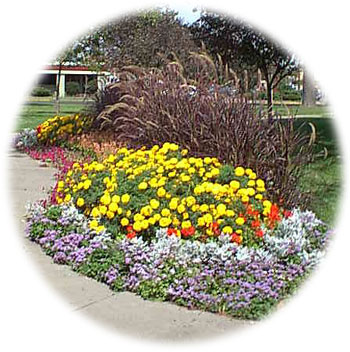
California and Overland Trail Markers - Six identical granite markers were erected on July 4, 1923. The historical markers mark the location of this trail across Hall County. The trail was used by immigrants during the Gold Rush to California in 1849, the Mormons, the military, and early settlers. The markers can be found in the following locations in Hall County, from east to west.
Corner of Seedling Mile and Gunbarrel Road.
Corner of Riverside Drive and Stagecoach Road, near the entrance to the Riverside Golf Course.
Stuhr Museum east of the Fonner Pavilion.
West side of the Alda Road, one mile south of Alda. The ruts of the trail can be seen behind the marker.
Platte Valley Academy Campus at the extreme west edge of Hall County.
West side of Highway 11 near Wood River.
Blunk's Mill Marker - Near this site in 1877, one of Hall County's first flour mills was built along the Wood River.
Mormon Trail Marker - Located on the grounds of the Stuhr Museum. The Nebraska State Historical Society marker describes the trek of the Mormons and the route they followed along the north side of the Platte River beginning in the 1840's.
Junctionville Marker - South of Grand Island and the Platter River on Old Highway 281. This stone marker marks the site of the stage station, post office and road ranche run by W.J. Burger in the early 1860's. At this site, the Nebraska City-Ft. Kearny Trail or cutoff entered the Platte River Valley and merged with the old Ox Bow Trail. The trail continues west through Hall County and merged with the Oregon Trial near the western edge of the county. IN 1879, Berger helped found the Village of Doniphan located four miles south.
The "Conflict of 1867" Marker - Corner of Highway 281 and Platte River Rd. west of Doniphan. This marker details what occurred during one of several Indian uprising in the 1860's. Beginning in the early 1860's, homesteaders along the valley were in frequent conflict with the Indians. In July 1867, both the Campbell and Warren homesteads were attacked. Four children of the Peter Campbell Family were kidnapped by Sioux Indians and Mrs. Thurston Angeline Warren was killed. The Campbell children were exchange at the meeting between the U.S. military and the Sioux Indian Chief, Turkey Leg.
Warren Marker - One mile west of Doniphan on Platte River Drive. Early settlers along the south side of the Platter River, the Warren Homestead was attacked by Sioux Indians in July, 1867. During the attack, Mrs. Warren died after an arrow pierced her chest. She was found in the doorway of her sod house nursing her infant baby.
Original Townsite of Wood River Marker - The town, Wood River, was named after the tree-lined river nearby. in 1874-75, the present site of Wood River was platted by the Union Pacific Railroad. The original site of Wood River was three miles south of the railroad, and in 1875, the post office, a store, and other buildings were placed on skids and moved to the present site.
Grand Island Historical Marker - A Nebraska State Historical Society marker about Grand Island is located at the rest stop along the eastbound land of I-80 east of the Grand Island-Hastings Exit.